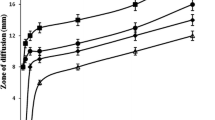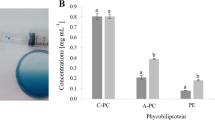Abstract
Application of natural colors in food and medicine, due to toxic effects of synthetic colors has been considered recently. Phycocyanin is regarded as the most preferred phycobilin pigment of cyanobacteria Spirulina because it has medical and medicinal features. In current study, phycocyanin was extracted and purified from Spirulina platensis using 5 freezing/thawing cycles, ultrasonic disruption, ammonium sulphate precipitation and dialysis. Purified phycocyanin was tested by UV-spectrophotometrically and using FT-IR and HPLC methods. The antifungal effect of purified phycocyanin was evaluated versus Candida albicans on sabouraud dextrose agar plates, and maximum anticandidal activity was revealed in the range from 20 to 25 mg/mL of phycocyanin. Making sure of phycocyanin’s antifungal effect, the efficacy of its produced cream (using 1.5 and 3% of phycocyanin compared to control) was investigated on mice infected with C. albicans. Based on obtained results, those groups of mice treated by formulation containing phycocyanin improved much sooner than control group.



Similar content being viewed by others
REFERENCES
Romani, L. J. Leukocyte Biol., 2000, vol. 68, no. 2, pp. 175–179.
Kullberg, B. and Oude, A.L. Eur. J. Med. Res., 2002, vol. 7, no. 5, pp. 183–191.
Romani, L., Candida and Candidiasis, Washington, D.C.: Am. Society Microbiol., 2nd ed., 2012, pp. 127–136.
Grzanna, R., Polotsky, A., Phong, V., Phan, B.S., Pugh, N., Pasco, D., et al., J. Altern. Complement. Med., 2006, vol. 12, no. 5, pp. 429–435.
Pugh, N., Ross, S.A., Elsohly, H.N., Elsohly, M.A., and Pasco, D.S., Plant Med., 2001, vol. 67, no. 8, pp. 737–742.
Jensen, G.S., J. Am. Nutraceutical Assoc., 2001, vol. 3, pp. 24–30.
Leiro, J.M., Castro, R., Arranz, J.A., and Lamas, J., Int. Immunopharmocol., 2007, vol. 7, no. 7, pp. 879–888.
Kaushik, P. and Chauhan, A. Ind. J. Microbiol., 2008, vol. 48, no. 3, pp. 348–352.
Ozdemir, G., Karabay, N.U., Dalay, M.C., and Pazarbasi, B., Phytother. Res., 2004, vol. 18, no. 9, pp. 754–757.
Akao, Y., Akazawa, T., Ebihara, T., Hazeki, K., Hazeki, O., Masuda, H., et al., Cancer Sci., 2009, vol. 100, no. 8, pp. 1494–1501.
Yang, Y., Park, Y., Cassada, D.A., Snow, D.D., Rogers, D.G., and Lee, J., Food Chem. Toxic., 2011, vol. 49, no. 7.
MacMillan, J.B., Ernest-Russel, M.A., de Ropp, J.S., and Molinski, T.F., J. Organic Chem., 2002, vol. 67, no.23, pp. 8210–8215.
Hirahashi, T., Matsumoto, M., Hazeki, K., Saeki, Y., Ui, M., and Seya, T., Int. Immunopharmocol., 2002, vol. 2, no. 4, pp. 423–434.
Subhashini, J., Mahipal, S.V.K., Reddy, M.C., Reddy, M.M., Rachamallu, A., and Reddanna, P., Biochem. Pharmacol., 2004, vol.68, no. 3, pp. 453–462.
Gheda, S.F., Khalil, M.A., and Gheida, S.F., Afric. J. Biotech., 2013, vol. 12, no. 18.
Su, H.N., Xie, B.B., Zhang, X.Y., Zhou, B.C. and Zhang, Y.Z., Photosynthesis Res., 2010, vol. 106, pp. 73–87.
Gault, P.M., and Marler, H.J. Handbook on Cyanobacteria: Biochemistry, Biotechnology and Application, Gault, P.M. and Marler, H.J., Ed., New York: Nova Science Publishers, 2009.
Eriksen, N.T., Appl. Microb. Biotech., 2008, vol. 80, no. 1, pp. 1–14.
Patil, G., Chethana, S., Sridevi, A.S., and Raghavarao, K.S.M.S., J. Chromatogr., 2006, vol.1127, no. 1–2, pp. 76–81.
Izadi, M. and Fazilati, M., Asian J.Green Chem., 2018, vol. 2, pp. 364–379.
Muthulakshmi, M., Saranya, A., Sudha, M., and Selvakumar, G., J. Algal Biomass Utilization, 2012, vol. 3, no. 3, pp. 7–11.
Mishra, P. and Prasad, S.M., Int. J. Pharm. Sci. Res., 2015, vol. 6, no. 3, pp. 1000–1007.
Ghosh, V., Saranya, S., Mukherjee, A., and Chandrasekaran, N., Colloids Surfaces B: Biointerfaces, 2013, vol. 105, pp.152–157.
Ozay, Y., Ozyurt, S., Guzel, S., Cimbiz, A., Olgun, E.G., and Cayci, M.K., Wounds: Compendium Clin. Res. Pract., 2010, vol. 22, no. 10, pp. 261–267.
Acker, J.P. and McGann, L.E., Cryobiology, 2003, vol. 46, no. 2, pp. 197–202.
Soni, B., Trivedi, U., and Madamvar, D., Biores. Tech., 2008, vol. 99, no. 1, pp. 188–194.
Benedetti, S., Rinalducci, S., Benvenuti, F., Francogli, S., Pagliarani, S., Giorgi, L., et al., J. Chromat. B, 2006, vol. 833, no. 1, pp. 12–18.
El-Baky, H.H.A., El-Baz, F.K., and El-Baroty, G.S., J. Med. Plants Res., 2008, vol. 2, no. 10, pp. 192–300.
Murugan, T. and Radhamadhavan, J., J. Pharm. Res., 2011, vol. 4, no. 11, pp. 4161–4163.
Mayer, A.M. and Hamann, M.T., Marine Biotech., 2004, vol. 6, no. 1, pp. 37–52.
Vinay, K., Usmani, S.K., and Shrivastava, J.N., Vegetos, 2009, vol. 22, no. 2, pp. 83–89.
Kumar, A., Saini, P., and Shrivastava, J.N., Ind. J. Exp. Biol., 2009, vol. 47, pp. 57–62.
Kumar, V., Bhatnagar, A.K., and Srivastava, J.N., J. Med. Plants Res., 2011, vol. 5, no. 32, pp. 7043–7048.
Tuney, İ., Cadirci, B.H., Unal, D., and Sukatar, A., Turk. J. Biol., 2006, vol. 30, no. 3, pp. 171–175.
Sivakumar, J. and Santhanam, P., Recent Res.Sci. Tech., 2011, vol. 3, no. 4, pp. 158–161.
Author information
Authors and Affiliations
Corresponding author
Ethics declarations
Conflict of interest. The authors declare that they have no conflict of interest.
Statement on the welfare of animals. All appropriate international and institutional guidance for the surveillance of mice were followed.
Rights and permissions
About this article
Cite this article
Zamani, N., Fazilati, M., Salavati, H. et al. The Topical Cream Produced from Phycocyanin of Spirulina platensis Accelerates Wound Healing in Mice Infected with Candida albicans . Appl Biochem Microbiol 56, 583–589 (2020). https://doi.org/10.1134/S0003683820050166
Received:
Revised:
Accepted:
Published:
Issue Date:
DOI: https://doi.org/10.1134/S0003683820050166




